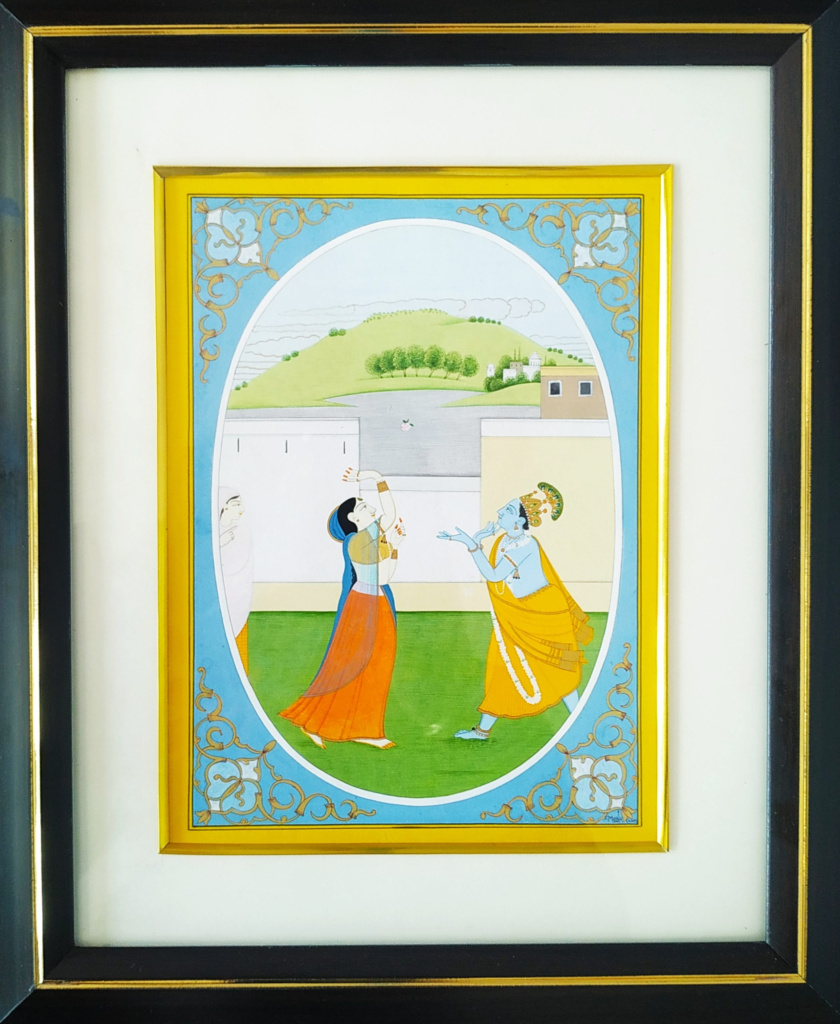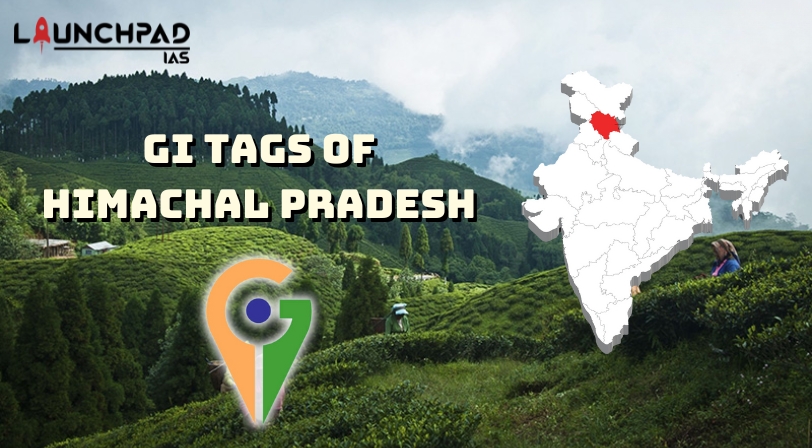The Geographical Indication (GI) tag is a status given to a product belonging exclusively to a particular area. The quality, reputation, and any other characteristics of that particular product are generally attributed to the geographical origin of the product. The GI Tags of Himachal Pradesh are listed below.
Chamba Chappal

- Chamba Chappals (slippers) are a tradition that dates back to the times of King Charat Singh (in the early ninth century).
- The major raw materials are sheep and goat skin, fancy leather, suede leather, locally made ordinary sole leather, chrome leather for the upper portion of slippers, and silver and golden threads known as ‘russi-tilla’. The designs on these chappals (slippers) consist of leaves and flowers.
- the striking feature of Chamba Chappals is the embroidery done on them. The embroidery, known as “Chamba Kadhai” is done separately on a velvet cloth or piece of felt using various bright-coloured silk threads such as pink, blue, yellow, purple, firozi, red, orange, brown, black, green, etc. The embroidery done with silk and golden threads is called russi-tilla.
- The motifs usually are of lantana flowers and leaves.
Kangra Tea

- It is a type of tea produced in the Kangra district of Himachal Pradesh.
- It is a high-quality tea that is known for its unique flavour, aroma, and colour.
- It is made from the leaves, buds, and tender stems of the Camellia sinensis species cultivated in the Kangra Valley.
- Black tea and green tea have both been cultivated in the Kangra Valley.
- In India, Kangra tea received the Geographical Indication (GI) designation in 2005.
- Features:
- Kangra tea leaves are narrow and have a multi-stemmed frame.
- Green tea has a subtle woody aroma, while black tea has a sweet, lasting aftertaste.
- It has a light colour and a high body in liquor.
Himachali Kala Zeera

- Himachali Kala Zeera or black cumin is one of the most economically important medicinal plants and spice that grows largely in Himachal Pradesh. Generally known to be found as a wild plant in the forests and grassy slopes of the North-Western Himalayas, kala zeera thrives in the high mountainous regions of Kinnaur, Kullu, Chamba, Shimla, Sirmaur, Lahaul–Spiti, Pangi, and Bharmaur that are at an elevation of 1850 – 3100 meters.
- The spice herb is small, grassy, and perennial and farmers collect the matured seeds from the forest areas.
- The major difference between Himachali kala zeera (Bunium persicum) and other species is the presence of higher concentrations of volatile oils, aldehydes, and a high percentage of Cuminaldehyde.
- This prized spice is valued for its medicinal, curative, and healing properties. As kala zeera has a very high percentage of volatile oil, it is treasured for its unique taste and flavour.
- Himachali kala zeera is darker and relatively sweeter as compared to other varieties, the taste of curries and dishes prepared using indigenous food grains is enhanced.
- This wild delightful spice was awarded the Geographical Indication Tag (GI) in 2017 for its distinctive taste and flavour and diverse uses.
Kangra Painting

- Kangra School of Painting was developed under the patronage of Raja Govardhan Chand (1744-1773), a prince with a refined taste and passion for painting. He gave asylum to refugee artists trained in the Mughal Style of painting.
- The artists adopted themes from the love poetry of Jayadeva Bihari and Keshav Das who wrote ecstatically of the love of Radha and Krishna.
- Thus, developed a school of painting with a new spirit, whose artistic works are suffused with romantic love and bhakti mysticism.
- The Kangra painters made use of pure colors like yellow, red, and blue and these have retained the brilliance, even after two hundred years.
- The central theme of Kangra painting is live and its sentiments are expressed in a lyrical style full of rhythm, grace, and beauty.
- The recurring theme of Kangra painting whether it portrays one of the six seasons or modes of music, Radha and Krishna or Shiva and Parvati is the love of man for woman and of woman for man.
Chamba Rumal

- Chamba Rumal is a pictorial craft that represents unique embroidery, which originated and flourished during the 17th –18th centuries in Chamba town in the State of Himachal Pradesh.
- In fact, “Rumal” is a Persian word that means a handkerchief. However, the embroidery work done on a hand-spun khaddar or a fine muslin cloth which is in square format, is known as Chamba Rumal.
- The Chamba Rumal derives its inspiration from Paintings in their general layout and themes, there is a predominance of figures of deities, especially of Vishnu in his different forms.
- The “dorukha-tanka” the double satin stitch that is used in the Chamba Rumal embroidery is unique, which is not noticed anywhere else in Indian embroidery tradition. This stitch placed closely side by side brings such extraordinary effect that the embroidery comes out strikingly identical on either side of the Rumal.
- The folk theme that would figure in this elegant work of craft included the Krishan Leela/Raas Leela.
Himachali Chulli Oil

- Chulli also known as Wild Apricot, Chulu, Share or Zardalu, mostly used for making Ghanti (a local liquor) and some handmade products, is grown as wild in many parts of Himachal Pradesh namely, Shimla, Mandi, Kullu, Chamba, Sirmour, Kinnaur and Lahaul-Spiti.
- The leftover stones or pits after the processing is thrown as waste which is otherwise used as a good source of edible oil which is rich in polysaturated fatty acids like linoleic and oleic acid which is of adequate nutritional and pharmaceutical importance.
- The oil is extracted both from Chulli (Wild Apricot) and Behmi (Peach). Behmi is a wild peach that is harvested from May to July and is highly perishable in nature. These fruits are hairy with whitish-yellow flesh.
- Behmis are smooth-skinned at maturity with a yellow skin overlaid with red, while its flesh is of yellow or yellowish-orange colour and is firm and sweet in taste. Lastly, no irrigation, manure, fertilization and pesticide control is used for their irrigation.
- Grown on deep and well-drained soils, these fruits contain a good source of sugar, vitamin A and appreciable amounts of Thiamine and Iron.
- These fruits are also used in the making of cosmetics namely face cream, water-based moisturizing gel, oil-based gel, hair oil (containing Vitamin A) and Hair Oil (containing Vitamin B); nutraceuticals i.e. apricot juices; and therapeutic like a pain reliever.
- Chulli Oil is essential for skin, hair growth and regulation of cholesterol metabolism as well as it is famous for reducing the risk of cardiovascular diseases. Chulli Oil finds its use in medicine for ear ache and other ailments and is also identical with bitter almond oil.
Lahauli Socks and Gloves

- The Lahauli socks and gloves are made from indigenous wool sheared from local sheep. A Lahauli pair of socks is knit in parts, using four double-pointed needles.
- Part of the foot is knit using eight colors into a traditional eye-catching pattern, locally called ‘dashi’, which comprises patterns composed of seven or eight types of motifs. Each ‘dashi’ is laid out in four or five rows in different colours.
Kinnauri Shawls

- The woolen Art fabric of Kinnaur is very old and it flourished in the erstwhile state of Rampur Bushehar. Due to traditional design on woolen shawls and caps the products are recognizably Kinnauri. It has been the nesting place of Hinduism and Buddhism.
- Kinnauri Shawl is known as Chhali in the local dialect. Ladies wear chhali toproo whereas gents wear plain chhali.
- The Kinnauri decorative designs are largely geometrical, executed in very soft and pleasing pastel shades.
- The Buddhist symbols executed in the five primary colors – white, yellow, red, green, and blue represent five elements viz., water, earth, fire, ether, and air respectively, while all five colors are used in the ornamentation, reds, yellows, and blues usually dominate.


